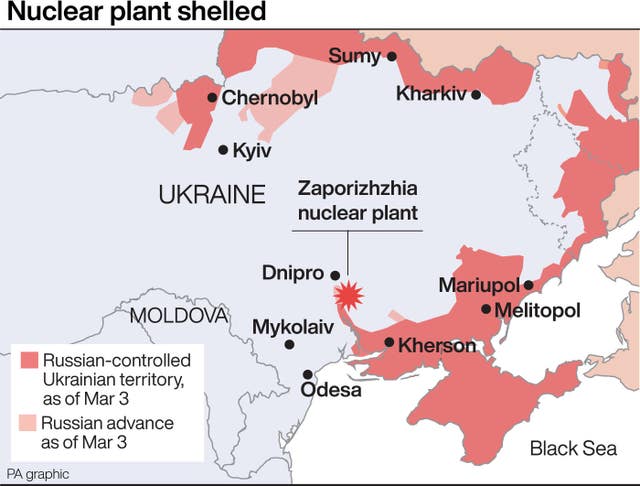Ukraine says nuclear plant offline after Russian shelling
Russia’s Defence Ministry claimed that Kyiv’s forces on Sunday targeted the territory of the plant with a drone.

Europe’s largest nuclear plant has been knocked off Ukraine’s electricity grid after a fire caused by Russian shelling brought down its last transmission line, the facility’s operator said.
Russian forces have kept up “intensive shelling” of the area around Zaporizhzhia in recent days, Energoatom said in a statement.
The International Atomic Energy Agency, a UN watchdog, said last Saturday that the plant had lost its last main line to the grid, but was still sending power to the grid through a reserve line.
Officials at the IAEA, which still has two experts at the plant, and Energoatom were not immediately available to explain the consequences of the line being cut.

The developments came a day before UN inspectors were due to report on their efforts to avert a potential disaster at the Ukrainian site that has been engulfed by Russia’s war.
The Russian military had earlier on Monday accused Ukrainian forces of staging “provocations” at the plant, which lies within a Russian-installed administrative area.
Russia’s Defence Ministry claimed that Kyiv’s forces on Sunday targeted the territory of the plant with a drone, which it said Russian troops were able to shoot down.
The ministry said Ukrainian troops also shelled the adjacent city of Enerhodar twice overnight.

The two sides have traded accusations about endangering the plant, which the Kremlin’s forces have held since early March. The plant’s Ukrainian staff continue to operate it.
In a perilous mission, experts with the International Atomic Energy Agency travelled through the war zone to reach the plant last week.
Four of six UN nuclear agency inspectors have completed their work and left the site, Energoatom, Ukraine’s state nuclear power plant operator, said Monday.
Two of the experts are expected to stay at the plant on a permanent basis, Energoatom said.
Ukraine’s presidential adviser, Mykhailo Podolyak, applauded the IAEA’s decision to leave some experts at the plant.
“There are Russian troops now who don’t understand what’s happening, don’t assess the risks correctly,” Mr Podolyak said.
“There is a number of our workers there, who need some kind of protection, people from the international community standing by their side and telling (Russian troops): ‘Don’t touch these people, let them work,’” he added.
The UN inspectors are scheduled to brief the Security Council on Tuesday about what they found out on their visit. The plant is largely crippled, amid a grinding war that has clobbered energy markets.
Meanwhile, a senior Kremlin official blamed Western sanctions on Russia over its war in Ukraine for stoppages in Moscow’s supply of natural gas to Europe.
In some of the bluntest comments yet on the stand-off between Moscow and Western Europe over energy supplies, Kremlin spokesman Dmitry Peskov said problems with pumping the gas occurred “because of the sanctions”.
“Other reasons that would cause problems with the pumping don’t exist,” Mr Peskov claimed.
The sanctions on Moscow and Russian companies have created problems with equipment maintenance, he said, though that claim has been refuted by Western governments and engineers.
Russian energy company Gazprom announced on Friday that a suspension of gas supplies heading westwards through the Nord Stream 1 pipeline would be extended indefinitely because oil leaks in turbines need fixing.
That move brought a surge in European natural gas prices and walloped global stock markets.
High energy prices and possible shortages this winter in Western Europe have set alarm bells ringing among governments, notably those in the European Union.
Mr Peskov laid the blame for the disruption firmly at the door of the sanctions, which he claimed have prevented machinery from working properly, even though experts say that is not true.
German officials have rejected those explanations, saying they are merely a political power play. Germany’s Siemens Energy, which manufactured turbines the Nord Stream 1 pipeline uses, said turbine leaks can be fixed while gas continues to flow through the pipeline.





